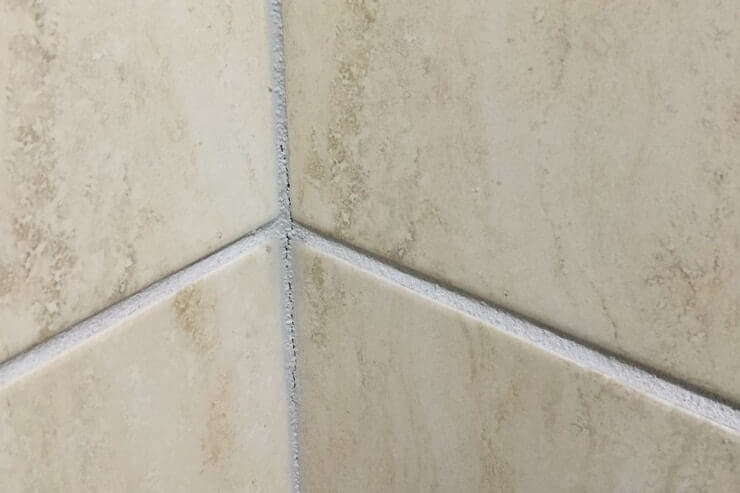If you've noticed small cracks in your kitchen wall, don't panic. These hairline cracks are a common occurrence in homes and can easily be repaired with some basic tools and materials. In this guide, we'll walk you through the steps to fix those pesky cracks and restore your kitchen wall to its former glory.How to Repair Hairline Cracks in a Kitchen Wall
Drywall is a popular material used for interior walls, and it is prone to developing hairline cracks over time. The good news is that these cracks are usually easy to fix. Start by cleaning the area around the crack with a damp cloth and removing any loose debris. Next, apply a thin layer of joint compound using a putty knife, making sure to cover the crack completely. After it dries, sand the area smooth and paint over it for a seamless finish.How to Fix Hairline Cracks in Drywall
If you're the type of person who likes to take on home repairs yourself, fixing hairline cracks in walls is a task you can easily tackle. The first step is to identify the cause of the crack, which could be anything from settling of the house to temperature changes. Once you've determined the cause, you can choose the appropriate method for repair. For small cracks, a simple patching compound will do the trick. For larger cracks, you may need to use a joint tape to reinforce the area before applying the compound.DIY Guide to Fixing Hairline Cracks in Walls
As mentioned before, hairline cracks in kitchen walls can be caused by a variety of factors. One common cause is moisture, which can cause the wall to expand and contract, resulting in cracks. To prevent this, make sure your kitchen is well-ventilated and check for any leaking pipes. Another common cause is settling of the house, which can happen over time and cause cracks to form. If this is the case, consult a professional to assess the situation and make any necessary repairs.Causes and Solutions for Hairline Cracks in Kitchen Walls
When it comes to repairing hairline cracks in walls, there are many products on the market that claim to do the job. However, not all of them are created equal. For the best results, look for a patching compound that is specifically designed for wall repairs. These compounds are usually easy to apply and dry quickly, saving you time and effort. Some popular brands include DAP, Red Devil, and 3M.Best Products for Repairing Hairline Cracks in Walls
To help you through the process, here is a step-by-step guide to fixing hairline cracks in kitchen walls: Step 1: Clean the area around the crack with a damp cloth to remove any dirt or debris. Step 2: Use a putty knife to apply a thin layer of joint compound over the crack, making sure to cover it completely. Step 3: Let the compound dry according to the manufacturer's instructions. Step 4: Once the compound is dry, sand the area smooth using fine-grit sandpaper. Step 5: Wipe away any dust with a damp cloth and let the area dry completely. Step 6: Paint over the repaired area to blend it in with the rest of the wall.Step-by-Step Guide to Fixing Hairline Cracks in Kitchen Walls
While hairline cracks in walls are common and can be easily repaired, it's always better to prevent them from happening in the first place. Here are some tips to help you keep your kitchen walls crack-free: 1. Keep your kitchen well-ventilated: Proper ventilation is key in preventing moisture buildup, which can cause cracks to form. 2. Check for leaks: Regularly check your kitchen for any leaking pipes or appliances that could be causing water damage to your walls. 3. Use quality materials: When building or renovating your kitchen, make sure to use high-quality materials that are less likely to develop cracks. 4. Avoid extreme temperature changes: Sudden changes in temperature can cause walls to expand and contract, leading to cracks. Keep your kitchen at a consistent temperature to prevent this.Tips for Preventing Hairline Cracks in Kitchen Walls
If your kitchen walls are made of plaster, the process for fixing hairline cracks is slightly different. Instead of using joint compound, you'll need to use a patching plaster. Start by widening the crack with a putty knife, then brush away any loose debris. Next, mix the patching plaster according to the instructions and apply it to the crack with a putty knife. Once it dries, sand the area smooth and paint over it for a seamless finish.How to Patch Hairline Cracks in Plaster Walls
While fixing hairline cracks in walls may seem like a simple task, there are some common mistakes that people make that can lead to bigger problems. These include using the wrong type of patching compound, not properly cleaning the area before applying the compound, and not allowing enough time for the compound to dry. To avoid these mistakes, make sure to carefully follow the instructions on your chosen product and take the time to properly prepare the area before beginning the repair.Common Mistakes to Avoid When Repairing Hairline Cracks in Walls
If you're not confident in your DIY skills or the damage is extensive, it may be best to call in a professional to repair the hairline cracks in your kitchen walls. Professional contractors have the experience and tools necessary to fix the cracks quickly and effectively. They may also be able to identify any underlying issues that could be causing the cracks and provide a long-term solution.Professional Techniques for Repairing Hairline Cracks in Kitchen Walls
Dealing with Kitchen Hairline Cracks on Walls: A Guide to House Design

The Importance of a Well-Designed Kitchen
 A kitchen is often considered the heart of a home, where meals are cooked and memories are made. It is a space that serves multiple purposes, from cooking and dining to socializing and entertaining. That is why it is crucial to have a well-designed kitchen that is not only functional but also aesthetically pleasing. However, even the most carefully planned kitchen can develop hairline cracks on its walls over time. These cracks not only mar the appearance of your kitchen but can also be a sign of underlying structural issues. In this article, we will discuss the causes of kitchen hairline cracks on walls and how to deal with them in the context of house design.
A kitchen is often considered the heart of a home, where meals are cooked and memories are made. It is a space that serves multiple purposes, from cooking and dining to socializing and entertaining. That is why it is crucial to have a well-designed kitchen that is not only functional but also aesthetically pleasing. However, even the most carefully planned kitchen can develop hairline cracks on its walls over time. These cracks not only mar the appearance of your kitchen but can also be a sign of underlying structural issues. In this article, we will discuss the causes of kitchen hairline cracks on walls and how to deal with them in the context of house design.
The Culprits Behind Kitchen Hairline Cracks
 Kitchen hairline cracks
are small, thin cracks that form on the walls and ceilings of your kitchen. These cracks can be caused by a variety of factors, including settling of the foundation, fluctuations in temperature and humidity, poor construction techniques, and even normal wear and tear. They may start as tiny imperfections but can quickly spread and become more noticeable, especially on
drywall
or
plaster walls
. While some hairline cracks are superficial and can be easily fixed, others may be a symptom of bigger problems that require professional attention.
Kitchen hairline cracks
are small, thin cracks that form on the walls and ceilings of your kitchen. These cracks can be caused by a variety of factors, including settling of the foundation, fluctuations in temperature and humidity, poor construction techniques, and even normal wear and tear. They may start as tiny imperfections but can quickly spread and become more noticeable, especially on
drywall
or
plaster walls
. While some hairline cracks are superficial and can be easily fixed, others may be a symptom of bigger problems that require professional attention.
Dealing with Kitchen Hairline Cracks
 If you notice hairline cracks on your kitchen walls, the first step is to determine the cause. If the cracks are due to settling of the foundation, it is essential to address the underlying issue to prevent further damage. In this case, a professional
structural engineer
should be consulted to assess the situation and provide a solution. If the cracks are a result of temperature and humidity fluctuations, it may be necessary to install a dehumidifier or improve ventilation in your kitchen.
For superficial hairline cracks, there are several
DIY
methods to fix them. One simple solution is to fill the cracks with spackling compound or joint compound and then sand and paint over them. However, if the cracks are larger or recurring, it is best to call in a professional contractor to properly repair and seal them.
If you notice hairline cracks on your kitchen walls, the first step is to determine the cause. If the cracks are due to settling of the foundation, it is essential to address the underlying issue to prevent further damage. In this case, a professional
structural engineer
should be consulted to assess the situation and provide a solution. If the cracks are a result of temperature and humidity fluctuations, it may be necessary to install a dehumidifier or improve ventilation in your kitchen.
For superficial hairline cracks, there are several
DIY
methods to fix them. One simple solution is to fill the cracks with spackling compound or joint compound and then sand and paint over them. However, if the cracks are larger or recurring, it is best to call in a professional contractor to properly repair and seal them.
Preventing Kitchen Hairline Cracks in the Future
 While it is impossible to completely prevent hairline cracks from appearing in your kitchen, there are some steps you can take to minimize their occurrence. These include using
high-quality materials
during construction, ensuring proper ventilation and insulation, and regularly checking for any signs of foundation settling or other structural issues. It is also crucial to maintain a consistent temperature and humidity level in your kitchen, as extreme fluctuations can cause stress on the walls.
In conclusion, a well-designed kitchen is not just about aesthetics but also functionality and structural integrity. Understanding the causes of kitchen hairline cracks and taking proactive measures can help prevent them from becoming a recurring issue in your home. By addressing these cracks
promptly
and
properly
, you can ensure that your kitchen remains a beautiful and functional space for years to come.
While it is impossible to completely prevent hairline cracks from appearing in your kitchen, there are some steps you can take to minimize their occurrence. These include using
high-quality materials
during construction, ensuring proper ventilation and insulation, and regularly checking for any signs of foundation settling or other structural issues. It is also crucial to maintain a consistent temperature and humidity level in your kitchen, as extreme fluctuations can cause stress on the walls.
In conclusion, a well-designed kitchen is not just about aesthetics but also functionality and structural integrity. Understanding the causes of kitchen hairline cracks and taking proactive measures can help prevent them from becoming a recurring issue in your home. By addressing these cracks
promptly
and
properly
, you can ensure that your kitchen remains a beautiful and functional space for years to come.
Convert to HTML Code

Dealing with Kitchen Hairline Cracks on Walls: A Guide to House Design

The Importance of a Well-Designed Kitchen

A kitchen is often considered the heart of a home, where meals are cooked and memories are made. It is a space that serves multiple purposes, from cooking and dining to socializing and entertaining. That is why it is crucial to have a well-designed kitchen that is not only functional but also aesthetically pleasing. However, even the most carefully planned kitchen can develop hairline cracks on its walls over time. These cracks not only mar the appearance of your kitchen but can also be a sign of underlying structural issues. In this article, we will discuss the causes of kitchen hairline cracks on walls and how to deal with them in the context of house design.
The Culprits Behind Kitchen Hairline Cracks

Kitchen hairline cracks are small, thin cracks that form on the walls and ceilings of your kitchen. These cracks can be caused by a variety of factors, including settling of the foundation, fluctuations in temperature and humidity, poor construction techniques, and even normal wear and tear. They may start as tiny imperfections but can quickly spread and become more noticeable, especially on drywall or plaster walls . While some hairline cracks are superficial and can be easily fixed, others may be a symptom of bigger problems














:max_bytes(150000):strip_icc()/repair-cracks-in-plaster-walls-1822837-Final2-eb4576701da34987874f54b3275cdd5d-1af22f4dabf04373ae7742ccc6ffb37c.jpg)































































